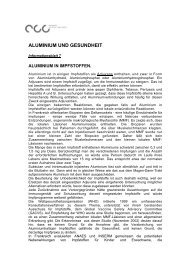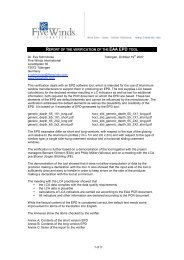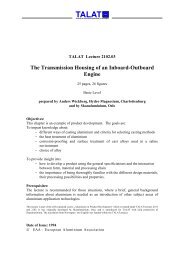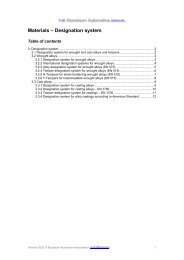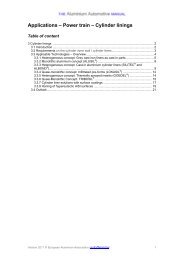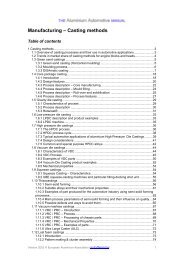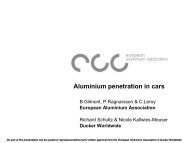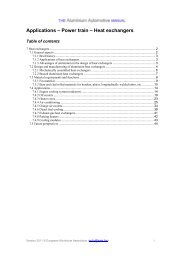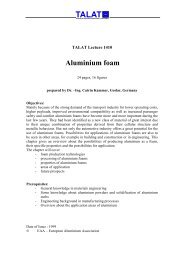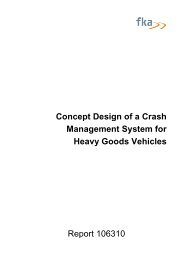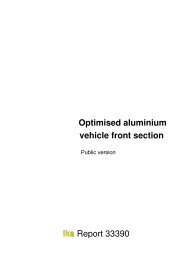aluminium in commercial vehicles - European Aluminium Association
aluminium in commercial vehicles - European Aluminium Association
aluminium in commercial vehicles - European Aluminium Association
You also want an ePaper? Increase the reach of your titles
YUMPU automatically turns print PDFs into web optimized ePapers that Google loves.
132 EUROPEAN ALUMINIUM ASSOCIATION ALUMINIUM IN COMMERCIAL VEHICLES CHAPTER IX<br />
Prototype floor section made<br />
of bonded sheets and extruded<br />
stiffeners<br />
1.4. Application<br />
of adhesives<br />
As adhesive bond<strong>in</strong>g is work<strong>in</strong>g<br />
by surface forces, prerequisites<br />
for a well function<strong>in</strong>g adhesive<br />
jo<strong>in</strong>t are<br />
a) the choice of an appropriate<br />
adhesive for the materials to be<br />
comb<strong>in</strong>ed<br />
b) the existence of a suitable<br />
material surface<br />
A suitable surface means, that<br />
the surface area must be large<br />
enough to transfer the applied<br />
forces and that it is capable to<br />
ensure a proper bond<strong>in</strong>g. This<br />
can be achieved through a<br />
suitable pre-treatment. Any<br />
residues of dirt like moisture,<br />
oils, dust etc. must be removed<br />
prior to application of the adhesive.<br />
This can be done by chemical<br />
means with the use of<br />
detergents, degreasers or etch<strong>in</strong>g<br />
agents or mechanically by<br />
gr<strong>in</strong>d<strong>in</strong>g. In any case the surface<br />
must be absolutely clean before<br />
glu<strong>in</strong>g. It might be favourable to<br />
use a primer for better wett<strong>in</strong>g<br />
of the metal surface by the<br />
adhesive as well.<br />
Patented by Alcan<br />
The jo<strong>in</strong>t construction should be<br />
related to the adhesion process<br />
and its requirements for large<br />
bond<strong>in</strong>g areas. Peel<strong>in</strong>g and<br />
cleav<strong>in</strong>g forces on adhesive<br />
jo<strong>in</strong>ts must be avoided and<br />
bend<strong>in</strong>g forces should be<br />
reduced to a m<strong>in</strong>imum.<br />
The adhesive can be applied<br />
manually (e.g. with the use of<br />
cartridges) or for larger areas<br />
with automated mach<strong>in</strong>es. The<br />
bond<strong>in</strong>g should take place <strong>in</strong> a<br />
dry and well ventilated and<br />
dust-free workshop.<br />
The work must be done <strong>in</strong> strict<br />
compliance with the manufacturer<br />
s rules. The production parameters<br />
such as res<strong>in</strong>/hardener ratio,<br />
duration and pressure component<br />
fit up dur<strong>in</strong>g adhesive cur<strong>in</strong>g, cur<strong>in</strong>g<br />
temperature, etc. must be controlled<br />
properly.<br />
1.5. Creep and age<strong>in</strong>g<br />
The durability of adhesive jo<strong>in</strong>ts<br />
depends on factors such as proper<br />
pre-treatment, chemical composition<br />
of the adhesive and<br />
service conditions like stresses,<br />
temperature, humidity and exposure<br />
to ultraviolet radiation (polymers<br />
are sensitive to this k<strong>in</strong>d of<br />
radiation and tend to lose their<br />
mechanical properties).<br />
The age<strong>in</strong>g of bonded jo<strong>in</strong>ts can<br />
be caused by creep under stress<br />
(creep can be def<strong>in</strong>ed as timedependent<br />
<strong>in</strong>crease <strong>in</strong> the<br />
length of visco-elastic substances<br />
subject to a constant<br />
tensile load).<br />
Adhesive jo<strong>in</strong>ts should therefore<br />
be <strong>in</strong>spected regularly to prevent<br />
damages and to enable<br />
repair prior to a possible failure.



